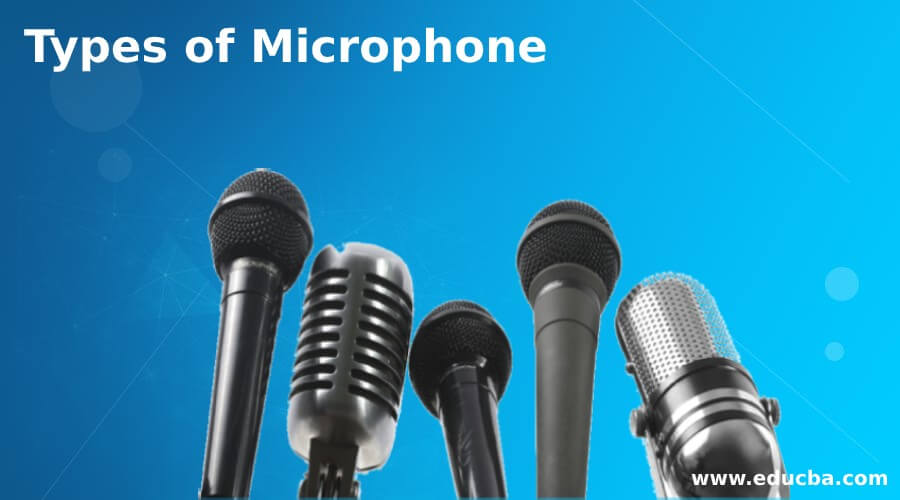
Introduction to Microphone
A microphone is called a mike or mic comprised of a transducer, which converts sound signals to electrical signals. It is used in applications like hearing aids, telephone, public address systems for public events, concert halls, production of motion pictures, recorded and live audio engineering, recording of sound, dual-way radios, television, and radio broadcasting, and in systems for voice recording, recognition of speech, VoIP, and non-acoustic functions like knock sensors or ultrasonic sensors. Different types of microphones are employed to transform air pressure variations in a sound wave into electrical signals.
Different Types of Microphone
The different types of microphones are ribbon mics, bass mics, multi-pattern mics, USB mics, dynamic mics, mikes with the small-diaphragm condenser, mikes with the large-diaphragm condenser, and boundary mics. But the most commonly used is a dynamic microphone with a wire coil on the magnetic field. In the capacitor plate, the condenser microphone uses the vibrator diaphragm to convert the electrical signals. The piezoelectric microphone uses piezoelectric material for electric signal conversion. Before the signal is reproduced or recorded, typical microphones should be connected to a preamplifier. So it is up to the user to choose the right tool according to his requirement.
1. Dynamic Microphones
In the world of microphones, they are like workhorses. It is durable and cheap, with enormous sound on a few recording sources. It is comprised of a rotating induction coil held on the magnetic field. Here dynamic mike operates like a speaker, which is vice versa. It is sensitive to transient spikes to manage the high level of SPL. So it made itself a natural choice for loud sound sources like guitar and bass cabs and drum kits with close mics. Increasing the sound system for your requirement and sophistication is versatile and affordable.
The microphone SM57 is one of the common tools in recording, which is user-friendly and highly accessible. Shure SM57 has one room with a dedicated single contender. It has impressive dynamic designs operating on studio scenarios like Shure SM7B, Sennheiser MD41, and Electrovoice RE20. Among the various options, the SM57 offers a great price-to-performance ratio, making it a suitable and reliable choice.
2. Microphones with Large Diaphragm Condenser
It is the most popular studio recording mike, which is stylish, large, serious, and highly professional. It uses a capacitor to transform the acoustic vibrations into electrical currents. It requires a power source with 48V for functioning. It is sensitive to ribbon and dynamic mics and delivers a louder signal output. So this sensitivity makes it a quiet and ideal choice for end dynamic sources like vocals. Because the microphone with a large-diaphragm condenser exhibits several numbers of pleasing sonically voices with maximum quality.
It helps to develop a larger-than-life sound and relate it with the vocals of a pro studio. It is effective for varied kinds of sources and available as a single piece to manage the entire task. Most trending LDC provide selective polar patterns, making them incredibly versatile and helpful in varied recording scenarios, which is the best mic for developing the studio.
3. Microphone with Small Diaphragm Condenser
It is mainly known as pencil condensers because of their tiny-sized, minimum flashy brother of LDC. But the sound blowing out from it is unbelievable. Irrespective of size, small diaphragmed microphones are most effective and have wide applications. It is highly transient sensitivity and limited pickup patterns with extended top-end modules. It makes it excellent for real stereo methods and suitable for acoustic instruments. It is applicable primarily in the recording session of classical music. The pair of stereo recordings allows for the development of precise stereo images with actual acoustic space.
4. Ribbon Mics
In earlier days, people used a traditional microphone. Ancient-age presenters are observed speaking into classical ribbon microphones.
It comprises an ultra-thin with an electro-conducting component held between magnetic poles to produce their signals. Unfortunately, the ribbon structure remains fragile, and improper movement or exposure to high SPL can still result in ribbon breakage. But the durability of sound in ribbon microphone has a worth trade-off and has a vintage tone with a warming prize.
It is perfectly suitable when people need to train highly high-end components like a drum with brass, guitar, and amps. It naturally develops a correct figure with a polar pattern of structure eight and is reactive to extreme quality. The ribbon mic has undergone significant development and no longer poses major risks of damage like the fragile early designs did. It causes damage to condensers and dynamic situations. It doesn’t require any 48V supply to ribbon mics and is a high risk to electrocuting of ribbon.
5. Cardioid Mics
This type of mic captures all things in block and front, focused on front-end patterns. It helps eliminate the sound source at a specific point and isolates it from the unambiguous sound, disturbing its original clarity and making the pleasant sound turn into noise. Therefore, it is suitable for live performances and other noise-reduction situations.
It is also helpful in the suppression of feedback. This mic can surpass the unnecessary polar patterns in a live performance, from simple karaoke to huge concerts. The other applications, like the mixing of loud instruments, include guitar speakers and drum kits. The subtle collaboration of sound has its off-axis with the correct position of the mike and entirely focuses on singing and speaking, eliminating errors.
6. Vocal Mics
Recording the vocal requires maximum attention to the singer’s nuances, where the microphone with a large-diaphragm condenser operates best. Shotgun and omnidirectional microphones capture choirs and groups.
Conclusion – Types of Microphone
Hence according to the requirement, the mics can be selected to get their effective usage.
Recommended Articles
This is a guide to Types of Microphone. Here we discuss the introduction and the different types of microphone, respectively. You may also have a look at the following articles to learn more –

